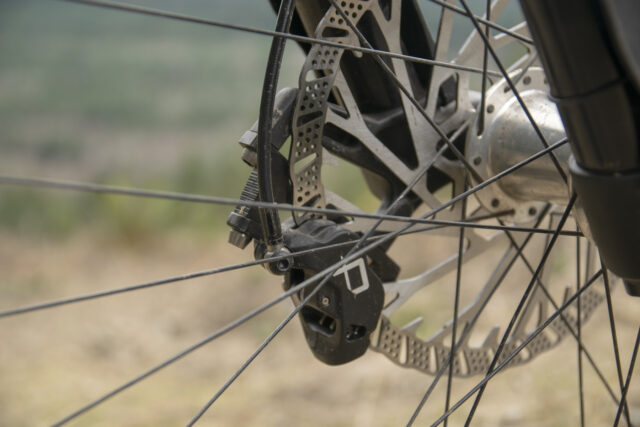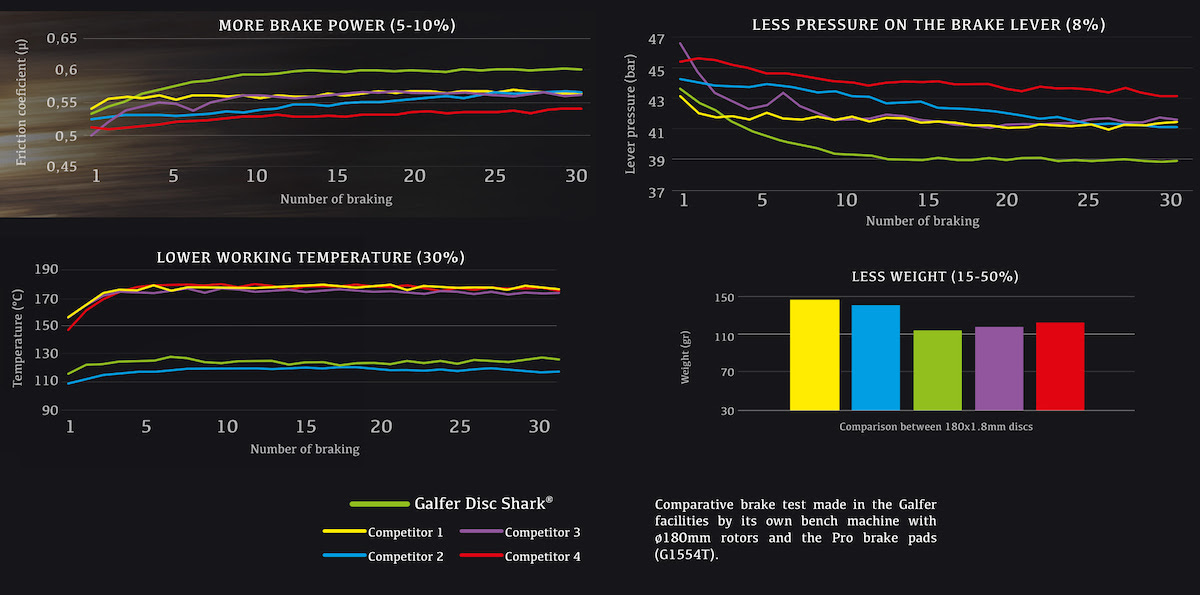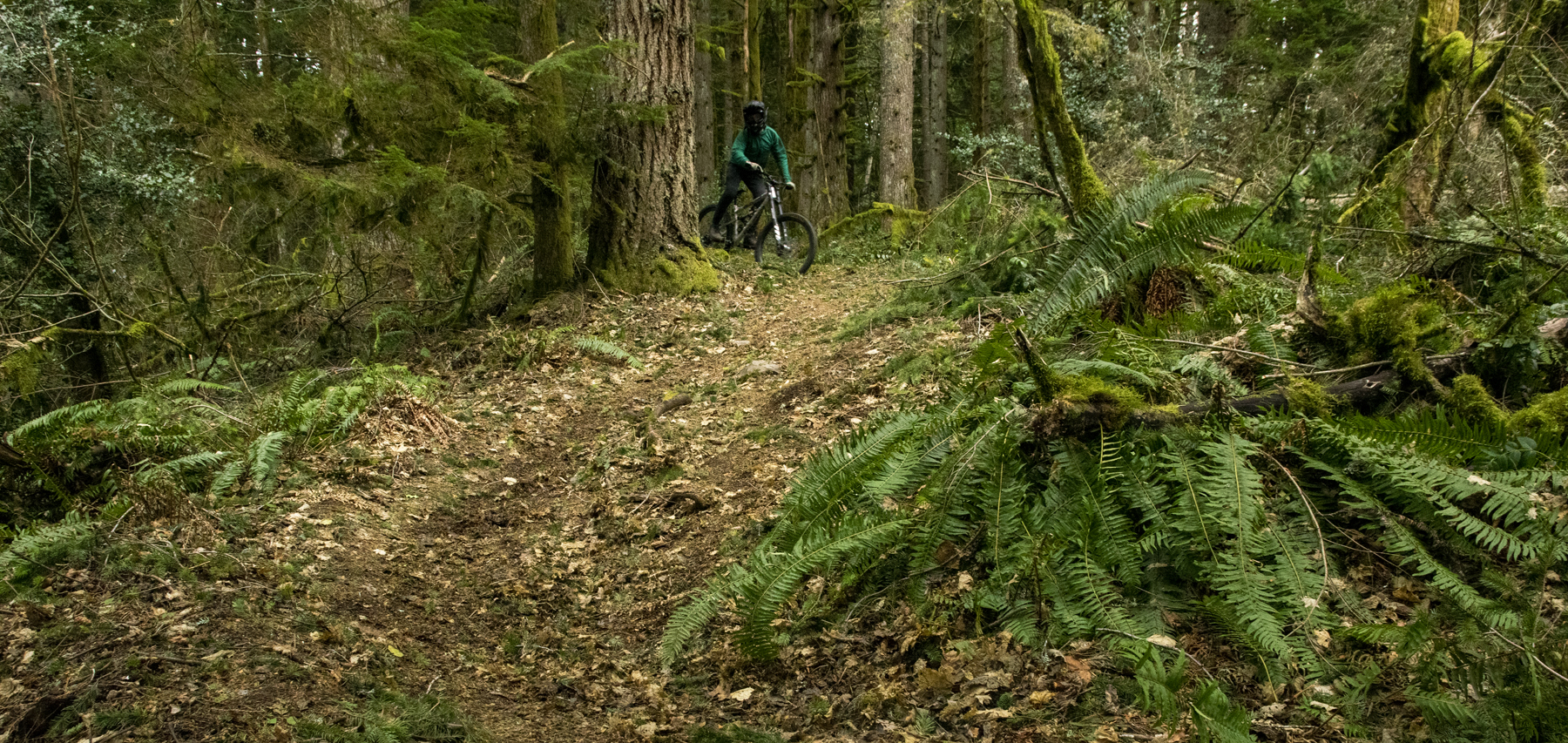Galfer Shark Rotors
Sizes Offered: 180, 203, and 223 mm x 2.0 mm
MSRP: $95 to $131
Blister’s Measured Weight:
- 203 x 2.0 mm: 177 g w/o bolts
- 223 x 2.0 mm: 239 g w/o bolts
Bolted to: Nicolai G1, w/ Hayes Dominion T4 and Hope Tech 4 V4 brakes
Reviewer: 6’, 170 lbs / 183 cm, 77.1 kg
Test Locations: Washington, British Columbia
Test Duration: ~6 months

Intro
During the 2021 World Cup Downhill season, eagle-eyed viewers started noticing some very unusual looking brake rotors on the bikes of a number of Commencal’s top racers. Those were Galfer’s Shark rotors, a design meant to improve heat dissipation as compared to the Wave rotors that we tested a while back (and still really like) — at the cost of, well, cost.
Now mere mortals can buy the Shark rotors, and we’ve been trying out a pair head-to-head with their less expensive Wave counterparts. The Shark rotors do indeed dissipate heat better, but should you care? And is it worth paying almost twice as much for the premium Shark version, or will the standard Wave rotors work just fine? It depends, so let’s dig in.
Design
The Shark rotors — so named for all the little cooling fins on the inside of the brake track — are primarily intended to help dissipate heat from the brake track, and keep the pads and rotors from overheating. They don’t actually use much more material than the standard Wave rotors to do so — in the 203 and 223 x 2.0 mm sizes for both, the Shark rotors are only about 10 g heavier. But their designs are entirely different, with the Shark rotors featuring an alternating pattern of longer slots that span nearly the full width of the braking track with a bunch of small, round holes in between them, plus the aforementioned shark fins for cooling purposes.


And that makes sense — we’ve generally found the braking power differences between good quality rotors of equal sizes to be fairly modest at optimal operating temperatures, but there are clear differences in how well different designs manage heat, and overheated brakes absolutely lose power, often in dramatic fashion.
The Shark rotors are available in six-bolt mounting only (though Galfer sells centerlock rotor adapters for them if you need those) and in 180, 203, and 223 mm diameters with a 2.0 mm thickness. Galfer has also announced a 160 mm x 1.8 mm thick version for XC use but they’re not available just yet.
As with all of Galfer’s rotors, the Shark ones are laser cut in their own facility in Spain from virgin high-carbon 420 stainless steel, which they say has a higher coefficient of friction than other grades of stainless. Despite being made in the same factory, from the same material, the Shark rotors are substantially more expensive than the Wave versions, at $95 to $131 apiece (varies by size) as compared to $62 for the 2 mm thick versions of the Wave. Galfer hasn’t commented directly on exactly why the Shark rotors are so much more expensive, but just on the basis of the design, it stands to reason that they’d require a lot more time on the laser cutter than the Wave rotors do. All the fins and little holes make for more total perimeter to cut out, and all the starts and stops in the cut (due to the number of little holes) add time as well.
On the Trail
In short, the Shark rotors work as advertised — they do make a real difference in heat dissipation under prolonged, hard braking as compared to Galfer’s Wave rotors or SRAM’s HS2 ones. But whether or not that’s a good thing isn’t quite as cut and dried. Particularly if you’re running very large rotors and / or riding in colder temperatures, the Shark rotors can take a little longer to get up to temperature and get the brakes working to their full potential.

Brake pad selection of course factors in there as well. I did the bulk of my testing with Galfer’s excellent Pro pads, which work notably well when cold, but also experimented with some full metallic sintered options. Those are far less effective before they get up to temperature, and the extra cooling of the Shark rotors did make that feel like it took a bit longer to get them working well in really cold, wet conditions.
But in warmer months and on longer, steeper descents, the extra heat dissipation of the Shark rotors was welcome. I can’t say that they make all that great a difference in outright braking bite under more optimal conditions (if anything, both Galfer variants are maybe a slight step up from the SRAM HS2s, but it’s truly slight). The real difference is that the Shark rotors are harder to get to fade under really heavy use and don’t fall off as dramatically or rapidly once they start to do so, and for some folks, that’s absolutely going to be worth the price of admission.
In general, I’d put moving to Shark rotors lower on my list of brake upgrade priorities than some combination of going to bigger rotors, upgrading brake pads (once again, Galfer’s Pro ones are truly outstanding) and / or upgrading brakes entirely, but for folks who want that extra bit of heat dissipation, they do work quite well. And having spent some time on Galfer’s monster 246 x 2.3 mm Wave rotors last summer, the Shark ones in the 223 mm front / 203 mm rear combo that I’ve been testing still have excellent heat dissipation while being easier for me to get up to proper operating temperatures. There’s no one-size-fits-all answer here, but the Shark rotors are a nice extra variable to play with if you’re really trying to dial in optimal brake performance for your preferences.

Bottom Line
Galfer’s Shark rotors really do dissipate heat better than the standard Wave ones and have been quiet, smooth, and generally performed great over six+ months of use (plus they look cool). Whether that’s worth the price premium for most folks is a trickier question to answer. Better heat dissipation is great if you’re riding extended, steep descents, particularly in high ambient temperatures, but brakes also work best when they’re warmed up to some extent, and there’s such a thing as having them run too cool, too.
If you have issues with brakes overheating and fading, the Shark rotors should help; if not, it’s not necessarily the case that more heat dissipation is better in all circumstances. As we so often say around here, it’s a case where it’s best to know thyself and be honest about whether or not you really need more heat dissipation from your brakes, but if you do, the Galfer Shark Rotors are here to help.

Might be a nice option for people running a mullet set up:
Run a smaller rear rotor to match the smaller rear wheel, for similar feel front /back.
But, a rear brake heats up more due to more frequent use, (and heat does not depend on shell size) and being more shielded from cooling, so the extra cooling would be welcome.
And, of course a great option for people whose fork or frame only takes a certain size rotor, but their weight and terrain leads to overheating with that size in a ‘normal’ rotor.